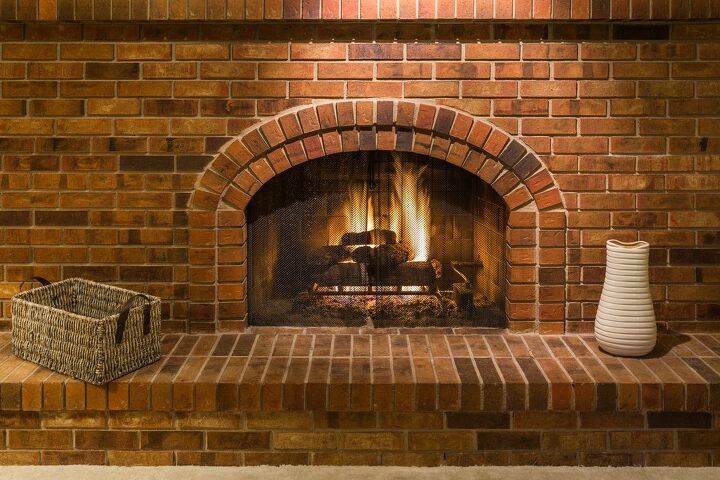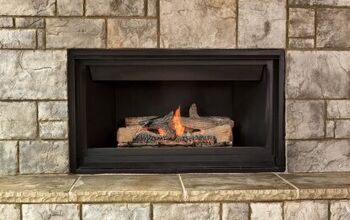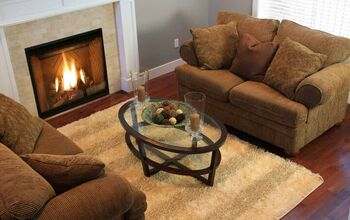Does a Gas Fireplace Need a Chimney?

Countless homeowners prefer gas fireplaces because they are simply easier to maintain than a wood-burning fireplace. Sure, gas fireplaces don’t burn wood and produce tar-filled smoke, but they create emissions. So, does a gas fireplace need a chimney?
A gas fireplace doesn’t need a chimney, but you need to vent it in many states. Several states such as Massachusetts and California require you to vent your gas fireplace to protect against carbon monoxide poisoning. You can reduce the harm of carbon monoxide emissions if you vent your gas fireplace or install a chimney.
Ventless gas fireplaces are legal in most states, but they are dangerous and deplete oxygen. It is also easier to clean and maintain a vented gas fireplace because there is less soot left behind from emissions. Follow along as we take a deep dive into why a gas fireplace doesn’t need a chimney.
Gas Fireplace Chimney Requirements
You don’t need a chimney if you have a gas fireplace. Gas fireplaces are different from wood-burning fireplaces because they don’t produce smoke. Wood-burning fireplaces require a chimney because they produce smoke and a strong odor that can fill your house.
One of the main appeals of a gas fireplace is that they don’t require wood which reduces bad odors and eliminates smoke. You don’t need a chimney whether you have a vented or ventless gas fireplace. However, it is possible to covert a fireplace with a chimney into a gas fireplace if you install a vent and gas lines.
You can also install a chimney for your gas fireplace if you simply like the appearance. Massachusetts and California both prohibit homeowners from installing ventless gas fireplaces. Building codes vary between municipalities as well so it’s important to check your local laws.
Can You Install a Chimney For a Gas Fireplace?
You can install a chimney for a gas fireplace, and that is a great way to vent it. The extra airflow will help diffuse emissions, take them outside, and prevent damage within your home. Homeowners typically spend at least $2,500 to install a chimney, but costs vary based on the contractor.
It is possible to convert an existing wood-burning fireplace with a chimney into a gas fireplace. You can expect to spend up to $4,000 to convert a wood-burning fireplace into a gas fireplace. However, it is much cheaper if you choose vented fireplace logs which are also much safer.
The main concern with installing a chimney for a gas fireplace is that debris or rain will enter it. Install a chimney cap for roughly $50 to keep dirt, debris, and rain out of your chimney. This will reduce maintenance and strengthen the fire in your gas fireplace.
Vented vs. Ventless Fireplace
Builder-owners are often torn between vented and ventless gas fireplaces. Both options are suitable for gas fireplaces, but the right one for you depends on several factors. Most experts will tell you that vented fireplaces are much safer, however, because they reduce carbon monoxide.
With that said, ventless fireplaces are the only option for some homeowners. The key difference between vented and ventless fireplaces is safety, but it doesn’t stop there. Let’s take a look at the differences between vented and ventless fireplaces.
Vented
Vented fireplaces vent smoke to the exterior of your home to remove harmful chemicals. Gas fireplaces don’t burn wood, but they still produce carbon monoxide. Vents allow the carbon monoxide to filter outside and dissipate so that it doesn’t build up inside of your home.
You can tell that there is too much carbon monoxide in the air if you notice yellow and brown soot marks near the gas fireplace. Install a vented fireplace if you notice soot marks because carbon monoxide can reach toxic and lethal levels in the air. Adding a vent to your gas fireplace won’t negatively affect the strength of the fire.
The flame may not burn quite as hot or vibrant as if it were a ventless fireplace, however. Extra airflow from the vent tends to slightly weaken the flame in a vented gas fireplace. However, it is worth it when you consider that a vented fireplace is infinitely safer than a ventless alternative.
Ventless
Ventless fireplaces are much less safe than vented fireplaces, and they aren’t legal everywhere. Many municipalities forbid builders and homeowners from installing a ventless fireplace. With that said, it is legal to install ventless fireplaces in several states, but that doesn’t mean they are safe.
You will also notice a strong chemical odor if you use a ventless fireplace that you wouldn’t experience with a ventless option. That is because there is little to no space for the fumes from the flame and the fuel source to dissipate. Gas fireplaces typically use natural gas or propane, and the smell of propane is easily noticeable.
Carbon monoxide and nitrous dioxide can build up in your home and set off the detector or cause harm. Ventless fireplaces may be legal in some states, but it is wise to vent your fireplace or install a chimney to minimize health risks. Never attempt to burn wood in a gas fireplace or ventless fireplace because it will cause further damage.
Direct Vent Vs. B-Vent
There are two types of vents that are suitable for a gas fireplace: direct vent and B-vent. Both are effective, and the ideal one for you largely depends on your home’s layout. For example, you likely need a B-vent if you have a chimney but want to increase ventilation.
However, you can reduce the need for a chimney if you install a direct vent for your gas fireplace. The differences are minor, but B-vents are considered the more natural option, albeit less efficient. Let’s explore the differences between direct vents and B-vents for a gas fireplace.
Direct Vent
Many builder-owners consider direct vents to be the best option because of how efficient they are. You won’t have to worry about heat loss because the air inside of your home isn’t a factor. The flame will likely burn hotter with a direct vent than with a B-vent.
It is easier to keep a fire going strong without having to turn up the fuel source with a direct vent. Too much air exposure can kill a flame or make it have to work harder. There are two chambers in a direct vent that each work to keep the fire going and remove emissions.
One chamber removes hot air with fumes and the other brings in cooler, fresh air. You can expect to spend up to $750 to install a direct vent for your fireplace. Costs vary, but it is labor-intensive because you must run a pipe through the wall and roof.
B-Vent
B-vents are the natural approach and simply rely on the air in your house. Many homeowners install a B-vent as an alternative to a chimney because they work similarly. B-vents are less substantial and noticeable than a chimney, however, and they take up less space.
They consist of vertical pipes that allow the emissions from the fire and fuel to escape your home. Fresh air from outside can also enter your home to help break up impurities in the air. Oxygen from inside of your home helps keep the fire going and pushes the emissions into the pipe.
What Happens if You Don’t Vent a Gas Fireplace?
Chemicals will accumulate in the air if you don’t vent a gas fireplace. Not only is it dangerous to breathe these chemicals, but they can also cause damage to your home. Soot accumulates as the fuel source keeps the fire going because it has nowhere to go.
You can potentially ruin the wallpaper and flooring near the gas fireplace if you don’t vent it. Soot can also form on furniture in the room, and that is an early sign of excess carbon monoxide. The toxins in the air can cause dizziness, nausea, lung irritation, and even death.
Animals and plants in the house are also at risk because gas fireplaces produce greenhouse gases. Greenhouse gases still form with ventless fireplaces, but they are less concentrated because the fumes can escape. You can also receive a fine if you fail to vent a gas fireplace in California and other states. Check with your local building department to see if it is legal to install a ventless fireplace.
Does a Gas Fireplace Need to be Cleaned?
You need to clean your gas fireplace at least once per year even though it doesn’t burn wood. Soot can form inside of gas fireplace because of the flame and natural gas or propane. However, it is much easier to clean a gas fireplace than a wood-burning fireplace, and that’s one of the main appeals.
Wood-burning fireplaces, conversely, require cleaning once per month or more depending on usage. You may even need to clean a wood-burning fireplace after every few fires if it gets messy. That will never happen with a gas fireplace because there is no creosote.
Creosote is the result of all of the tar that burns when you start a wood-burning fire. Without creosote, soot is all that you need to worry about when it comes to gas fireplaces. Vented gas fireplaces are generally easier to clean because the exhaust is less concentrated.
Do You Need a Chimney For an Electric Fireplace?
You don’t need to install a chimney if you have an electric fireplace, and they are completely safe. Many homeowners choose an electric fireplace because of how simple and safe they are. You don’t need a chimney because electric fireplaces don’t produce carbon monoxide, nitrous dioxide, or creosote.
Electric fireplaces are safer than wood-burning and gas fireplaces, but they don’t produce a real fire. Instead, they generate heat from electrical components that don’t require any combustion. The fact that they don’t produce real flames is a downside for some homeowners, but the safety benefits are hard to ignore.
You don’t want to leave an electric fireplace on overnight, however, because they can overheat or damage the electrical circuit. Chimneys are unnecessary because there are no emissions, and they could even be dangerous for an electric fireplace. Moisture and rain could enter the chimney and damage the electric fireplace which could create a fire hazard.
Summing It Up
You don’t need to install a chimney for a gas fireplace, but it is safe. It is a great idea to install a chimney for your gas fireplace, particularly if yours isn’t vented. A fireplace can serve as an alternative to a traditional fireplace vent, but you can install both.
Vented fireplaces are safer than ventless fireplaces because they help diffuse harmful emissions. Gas fireplaces produce carbon monoxide and nitrous dioxide which can both cause severe illness and even death. Clean your gas fireplace at least once per year if it is vented to remove yellow and brown soot.
Ventless gas fireplaces require more maintenance because soot will accumulate more quickly. Check to see if your municipality requires you to vent your gas fireplace. Even if they don’t require it, you should vent it or install a chimney to reduce safety risks.
Related Guides

Nick Durante is a professional writer with a primary focus on home improvement. When he is not writing about home improvement or taking on projects around the house, he likes to read and create art. He is always looking towards the newest trends in home improvement.
More by Nick Durante



























![Cost To Drill A Well [Pricing Per Foot & Cost By State]](https://cdn-fastly.upgradedhome.com/media/2023/07/31/9074980/cost-to-drill-a-well-pricing-per-foot-cost-by-state.jpg?size=350x220)